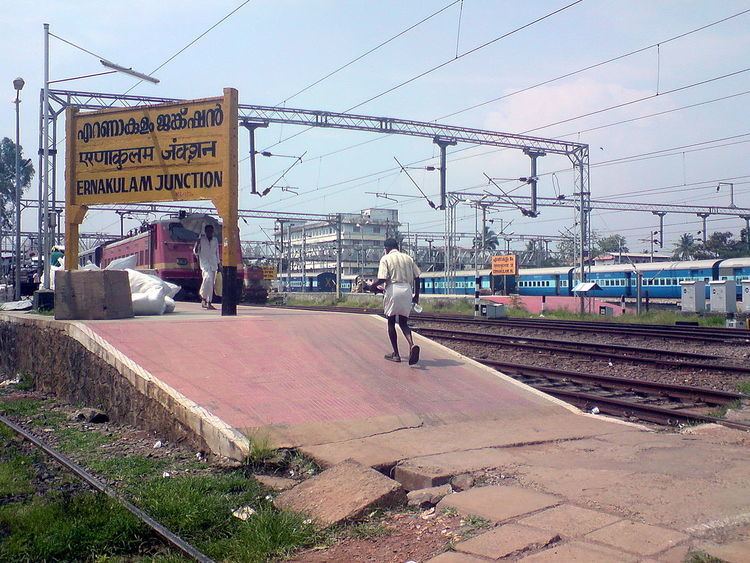Other names Ernakulam South Parking Available Phone 0484 237 5131 Rebuilt 1946 Tracks 12 | Opened 1932 Platforms in use 6 | |
 | ||
Line(s) Ernakulam-Kottayam-KayamkulamErnakulam-ShoranurErnakulam-Alappuzha-KayamkulamErnakulam Junction-Cochin Harbour Terminus Similar Kochuveli railway station, Thiruvananthapuram Central railway st, Aluva railway station, Shoranur Junction railway st, Thrissur railway station | ||
Entry to ernakulam junction railway station ernakulam south
Ernakulam Junction railway station (also known as Ernakulam South, code: ERS) is a major railway junction station in the city of Kochi in Kerala, India. At ₹158 crore (US$23 million), it is the second largest in terms in passenger revenues in Kerala and the fifth largest of the Southern Railway. It is an A1 classified station operated by the Southern Railway zone of the Indian Railways and comes under the Thiruvananthapuram railway division.
Contents
- Entry to ernakulam junction railway station ernakulam south
- Train arriving at ernakulam junction railway station
- History
- Layout
- Diesel Loco Shed
- References
Train arriving at ernakulam junction railway station
History
Ernakulam Jn was first opened as Ernakulam South in 1932 when the meter gauge line then terminating at Ernakulam (Old) Terminus (ERG) was extended from Pachalam to the Cochin Harbor Terminus (CHTS) Station on the Willingdon Island for proximity to the Kochi Port. Ernakulam North, Perumanur (later closed), Mattanchery Halt and CHTS were the newly opened stations on the route. In 1946 the station was converted into broad gauge as part of the Shoranur-CHTS line, linking it directly to the rest of India via the Mangalore-Jolarpet mainline at Shoranur Jn. In 1956 the Ernakulam-Kottayam meter gauge line was opened and further extended to Kollam in 1958, joining to the Kollam-Trivandrum line, connecting Ernakulam with Trivandrum for the first time.
Since the opening of the Kottayam line made it a junction, Ernakulam South was renamed Ernakulam Junction, and Ernakulam North was renamed Ernakulam Town. This was what made Ernakulam Jn rise to prominence, which was until then just a small wayside station en route to the much busier Cochin Harbour Terminus station. Until 1979 when the Kottayam line was converted into broad gauge, ERS had both broad and meter gauge tracks. As the coastal line to Alappuzha was opened in 1989, Ernakulam Jn rose to the status of the most premier railway station in central Kerala.
Layout
Ernakulam Jn is a railway junction with lines branching off from it to four different directions:
The station has six platforms to handle long distance trains and local trains and two entrances (the Main entry and the Eastern entry). Its A1 classification is the highest a station can achieve on Indian Railways. It does have all amenities expected out of a major junction including a paid air-conditioned lounge with free WiFi, a library, rest room, children's play areas etc. However, the station lacks the spread-out roominess and large built-up area of similarly large stations. Ernakulam Junction was the first railway station in Kerala to have an escalator. It was installed on 9 September 2013. Currently all its platforms are served by escalators.
Diesel Loco Shed
Ernakulam Diesel Loco Shed is one of the four diesel loco sheds of the southern railway and the only loco shed of any kind in the state of Kerala, and is the southernmost loco shed of the Indian Railways. The Diesel Loco Shed was set up in 1981 and handles around 56 diesel locomotives a month and employees 373 personnel. It undertakes repair, housing and maintenance of WDM2, WDM3A, WDG3A and WDS-6 and locos.
